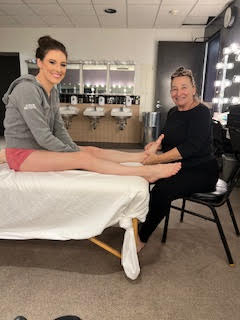Marika Molnar PT, LAc is the founder of the renowned Westside Dance Physical Therapy in New York City and is the director of Health & Wellness services to the New York City Ballet and Physical Therapy services through her clinic to the School of American Ballet. Her extensive work with ballet dancers — ranging from students to professionals— affords her unique insight into the demands the artform places on its devotees. I spent a decade in New York City as a dancer and was lucky enough to be cared for by Marika— she has the strongest hands of any physical therapist I have ever worked with. I recently had the opportunity to chat with Marika about her life-long experience with dance and dancers.
ORZA: Please tell us a bit about your background, including how you came to focus on working with dancers and, more specifically, dancers at the School of American Ballet (SAB) and the New York City Ballet (NYCB).
Marika: Growing up I was always dancing and doing gymnastics. I went to college and studied Health and Physical Education and then went on to get a master’s degree in dance education. My first job was teaching at a private girl’s school in Manhattan, where I taught dance and gymnastics to K-12th grade. It was at this time that I met Dr. William Hamilton (an orthopedic surgeon and dance medicine pioneer) as well as Barbara Horgan (founder of the George Balanchine Trust), who happened to be good friends with the mother of one of my students. We always got tickets to see the NYCB and, occasionally, even met Mr. Balanchine! I taught at that school for 5 years, and whenever we needed to, we would take the students to Dr. Hamilton to rule out serious injury. I then went to PT school at Columbia University. As soon as I graduated, Dr. Hamilton had me working with several dancers in the NYCB who had recently undergone surgery, as well as with Mr. B (George Balanchine) himself! And the rest is history.
ORZA: Are there common injuries that are very specific to ballet dancers, vs. athletes practicing other high impact sports? Are there injuries that overlap?
Marika: I think the most common injury which occurs in both ballet dancers and athletes is the lateral ankle sprain. Ballet dancers seem to have more stress reaction/stress fracture type injuries to the lower leg and foot. Additionally, the required increase in turn-out that dancers have makes their hips more susceptible to injuries.
ORZA: Do you see similar injuries between dance students and professional dancers? Are there some notable differences?
Marika: We have to remember that students are in their growing phase and can be tight and weak during their adolescence. They often have balance difficulties and also tend to push themselves to their limits, often culminating in ankle and knee sprains. We see Achilles and patella femoral tendon problems, heel pain, and Osgood Schlatter disease in in younger male dancers. If not treated correctly and in a timely manner, these injuries carry over to their adult dancing lives, causing problems throughout their professional careers.
ORZA: What would you recommend dance students consider when selecting a ballet shoe?
Marika: It is important that the shoe fits without squeezing the metatarsals and also that the toes can be straight and not forced to be curled or shortened. I also encourage dancers NOT to put the drawstring in a knot right over the second metatarsal and then tuck it in, as it can cause pressure on the bone. If they are returning from a foot injury, we often add a heel lift (1/8 or 1/4") if they do not have their normal plie, or if it was a posterior tendon problem. This reduces the load from compression.
ORZA: That is so interesting to hear about the lift you often manually add to shoes for dancers! The heel component parts in the Orza Pro One ballet shoe add ½ an inch of heel lift. Seth Orza designed the OP1 because he could not find a ballet shoe that met his unique athletic needs over the course of his 20+ years. What do you think accounts for the dancewear industry's lack of innovation around the ballet shoe?
Marika: I wish I knew, but I think is comes down to quantity. If they were making more of them and they knew that there would always be demand, then perhaps they would listen to their customer’s needs.
ORZA: The benefits of the OP1 compared to the traditional dance slipper are currently being studied by Karen Steere PT, Professor at the University of Puget Sound, and her team of graduate students. What do you think the results of this study might show us?
Marika: I imagine less Achilles issues and anterior ankle impingement as well as less stress reactions/fractures to the tibia and metatarsals.
ORZA: What do you see as the benefit of wearing Orza Pro One?
Marika: Better lower leg alignment on the whole and reduced injury to the dancer!
Thank you, Marika!
